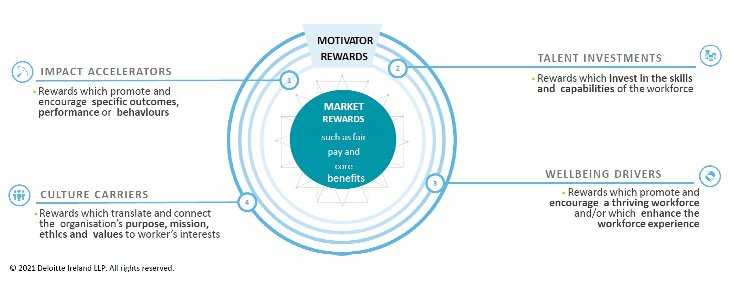
The key principle for organizations looking at rewards is to say ‘we value you’. It is important to check the differentiating factor (tangible and intangible) that makes an organization better to work at than the competition and also if this differentiating factor is still relevant in the current scheme of things.
When a business changes, as many have in the last 2 years, it is critical to refresh or reinvent the culture that led people to join the organization in the first place. Well-being, micro rewards with increased frequency, public recognition, human engagement, the small moments – we are already seeing businesses doing a total 180 on their people strategy, and it’s just the start.
Let us look at some of the distinguishing areas that will be critical in building a Total Rewards strategy for 2022:
Building a Strategic Total Rewards Operating Model
Enterprise changes are shifting organizations’ priorities, thus forcing total rewards to restructure the rewards package, adjust compensation plans, and price & negotiate salaries for new-to-world roles.
To strategically manage rewards in a changing enterprise it is important to restructure the Total Rewards Operating Model to engage the business, develop critical skills, and measure success.
The restructuring of the operating model for enterprise change will enable educating the business partners about Total Rewards topics enabling them to make informed trade-offs and focus on priority problems. It will also help to develop roles that enable collaboration & best-practice sharing and designating Total Rewards managers as network connectors within a distributed function.
We will also see organizations investing in assessing Total Reward’s impact on enterprise objectives by using metrics that align to the function and organization’s priorities and leveraging workarounds in the face of data challenges, such as building internal partnerships and accessing non-traditional data sources.
With each enterprise change, the organization’s work and priorities shift. The three most common changes that require Total Rewards to act are:
- Culture change – Total Rewards must restructure rewards packages to reflect HR strategy
- Restructuring – Total Rewards must adjust compensation plans to reflect new talent priorities
- Market expansion – Total Rewards must price and negotiate salaries for new-to-world roles
Market rewards will continue to be important for employees in an uncertain world. Motivator rewards will support enhancing employee experience, act as a differentiator and align employee and organisational goals and purpose.

Sustainable Well-Being Support
Many organizations boosted well-being support for employees during the pandemic. Difficult circumstances for many led to nearly half of the workforce looking to their organization’s well-being program for support.
Hence it is all the more important for the organizations to offer a comprehensive well-being program that responds to all facets of the individual, from the physical to the emotional, and address some of the new burdens that emerged over the past year, such as homeschooling.
In order to provide well-being support that works in 2022 and beyond, organizations and their total rewards leaders must:
- Commit to help employees cope with emerging and exacerbated stress factors like suffering from anxiety, home schooling, etc. even after the pandemic ebbs. We already see some organizations offering mental health support, flexible working hours or paid time-off to take care of children or elderly parents, reimbursement of child care expenses, enrolment of children in free online summer camp during school holidays, etc.
- Personalize support to meet varied employee needs. For example, a working parent trying to manage home schooling on top of a job has different needs than those of a single employee who is feeling lonely. Organizations can take specific steps to achieve alignment between support and demand
- Establish programs, processes and guidance that enable discussion of uncomfortable topics. These efforts should empower, but not force employees to discuss subjects they may otherwise be nervous to bring up, either because they perceive the topic as being historically stigmatized, contentious, too personal or a mix of all three
Customer-Centric Reward Experience
While thinking about a compensation philosophy, it is important to consider culture, employee value proposition, strategic goals, market competitiveness, internal and external equity and pay for performance. For example, customizing pay as per each business segment, recognizing top contributors by paying them above market, considering salary increases as an important pay-for-performance vehicle.
There are many different approaches towards administering pay, ranging from highly structured approaches to very flexible ones. The most prevalent and distinct salary structures are traditional grades, broadbands, pure market pricing, and hybrid structures.
To maximize impact, organizations need to not only design new reward offerings but also curate a new, customer-centric Reward experience for employees.
Listening to employees’ needs is critical. The ROI of listening pays off in terms of an appropriately allocated Total Rewards investment coupled with a consumer-grade approach, all of which shapes a desirable employee experience. Connecting employee experience to productivity, retention, or growth metrics shows the value of these change and communication investments.
Final Thoughts: There will still be businesses who will be questioning the ROI on rewards, but in this new world, I think the biggest question is what is the cost of NOT offering both tangible and intangible rewards.
As we move to a post-pandemic world, adaptive Total Rewards plans are critical to operating successfully. When organizations take a holistic view of Total Rewards and align their approach (and investment) to strategic priorities and workforce needs, organizations enhance the employee experience and drive success.
This creates a win-win and is essential to not just operating but thriving after the crisis and being able to withstand the next watershed moment.
Note: The views expressed herein are solely personal and do not reflect the views of the organization they represent.








